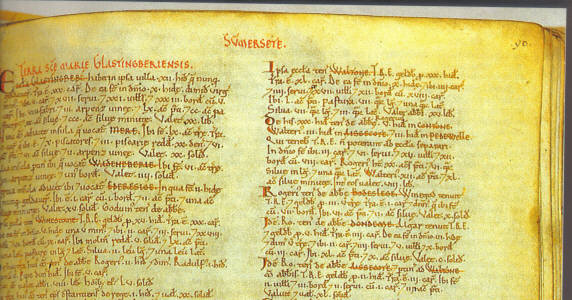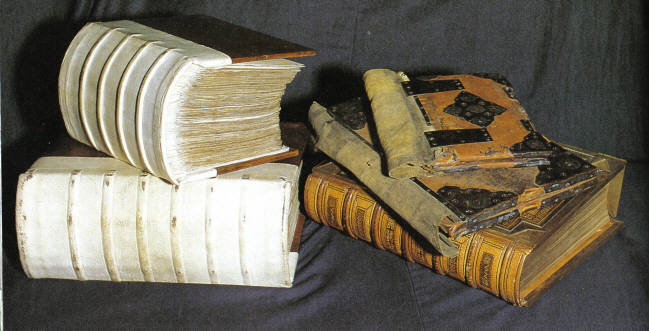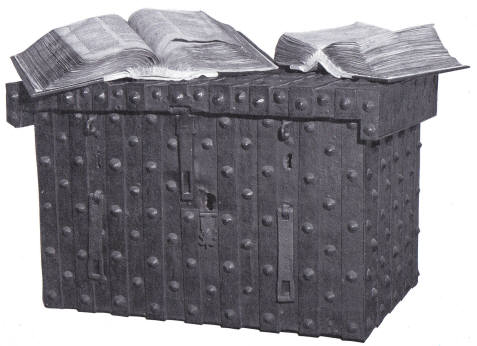The Domesday Book Entries – 1086
Along with the Magna Carta, the Domesday Book is possibly the best known English historical document. What can it tell us about our own area?
Of course there is no entry for Woburn Sands. The area now occupied by modern Woburn Sands would have fallen mainly under Wavendon in Buckinghamshire, and some under Aspley Guise in Bedfordshire.
Harold was King of England from January to October 1066. His predecessor, Edward the Confessor, had made William of Normandy his heir, but Harold seized the throne on Edwards’ death. Harold went straight into battle, with King Harold Hadrada of Norway, who had invaded in the north of England. The Norwegians were defeated, but Harold had to immediately march south, as William had invaded from France. They met at the Battle of Hastings, and William’s superior cavalry helped the French to victory. As the Normans did not recognise Harold’s claim to the throne, they referred to him only as ‘Earl Harold’.

King William I spent 20 years in settling his own people into the positions of land owners, by rewarding his own family, supporters and knights with generous gifts of land that had belonged to the Anglo-Saxons. He decided he wanted to know exactly what he had, and who was using it. So, in 1085, he commissioned the gathering of all this information into one book, The Domesday Book. Some say this was to maximise the taxation he could levy, as he feared an invasion by the Danes.
The Shires, as we know them, were already in place; Britain having been divided into administrative areas. Each of these was sub-divided in ‘Hundreds’. The Kings representatives went sent forth in 1086 with questions to ask at every local circuit court. These were then double checked by sending a different team to the same area.
A ‘Manor’ could be any large area of land, as large as a modern country estate or as small as a part of a village. The entries are arranged by the owners of the land, who paid their dues to the King. The names of the sub-tenants of this land are given, with details of how many men worked it, and an approximation of how much land there was, by giving how many ploughs it took to work the land. Villages were nowhere near the size you would know now. Most were just a collection of homesteads, spread out over a small area. As farms rose and declined, village names could move around, leading to difficulties in identifying exact locations today.
A ‘hide’ could vary in size, but Domesday experts have settled on an expression of 120 acres. A ‘hide’ was divided in 4 ‘virgates’ of 30 acres each.

‘Villigers’ were the next step down in the new English hierarchy. They are sometimes called ‘villans’ but are not the criminal sort! The worked the Lord of the Manors land as well as some of their own, and paid dues on what they farmed to him. Smallholders were similar, but the next social class down.
The lowest class of men were the ‘slaves’, who owned no land, and were personally owned by the Lord.
The values are expressed in old English shillings. The value of most land fell after 1066, as the armies laid waste to much of England, particularly in the north, taking whatever they needed and leaving the resident population to starve. Some villages disappeared overnight due to the pillaging by soldiers.
The following are the entries that refer to Wavendon and Aspley Guise. After each entry I have made a modern translation, as best I can.
Entries under Buckinghamshire
Land of the Count of Mortain
In Wavendon Ralph holds 2 hides from the Count as one manor.
Land for 2½ ploughs; in lordship 1.
2 villagers with 3 smallholders have 1 plough; [another] ½ possible.
1 slave; meadow for 2 ploughs; woodland, 15 pigs.
Value 20s; when acquired 10s; before 1066, 40s.
Godnir, King Edward’s Guard, held this manor; he could sell.
[In Wavendon, the Count of Mortain has let one manor, with a total of 240 acres to Ralph. There is enough farmed land for 2½ plough teams of 8 oxen, and one is used by Ralph himself. There are two peasant farmers, and three poor peasant farmers, who have land for between 1 – 1½ plough teams. There is one landless peasant. There is enough common land of hay for two plough teams; some woodland, and 15 pigs. The current total annual receipt of the Manor is 20s; when acquired by the Norman tenant it was 10s, but before 1066, it was 40s. Godnir, King Edward’s Guard, held this manor; he could sell.]
In the same [village] Walter holds 2 hides from the Count as one manor.
Land for 2½ ploughs; in lordship 1.
2 villagers with 3 smallholders have 1 plough; a further ½ possible.
2 slaves; meadow for 2 ploughs; woodland, 15 pigs.
Value 20s; when acquired 10s; before 1066, 40s.
Brictwin, Earl Harold’s man, held this manor; he could sell.
[In the same village, the Count of Mortain has let one manor, with 240 acres, to Walter. There is enough farmed land for 2½ plough teams of 8 oxen, and one is used by Walter himself. There are two peasant farmers, and three poor peasant farmers, who have land for between 1 – 1½ plough teams. There are two landless peasants. There is enough common land of hay for 2 plough teams; some woodland, and 15 pigs. The current total annual receipt of the Manor is 20s; when acquired by the Norman tenant it was 10s, but before 1066, it was 40s. Brictwin, Earl Harold’s man, held this manor; he could sell.]
In the same village Humphrey holds 3 virgates from the Count.
Land for 1 plough.
1 smallholder.
Meadow for 1 plough.
The value is and was 5s; before 1066, 10s.
Kentish, Leofnoth son of Osmund’s man, held this land; he could sell.
[In the same village, the Count of Mortain has let 90 acres to Humphrey. There is enough farmed land for one plough team of eight oxen. There is one poor peasant farmer, and enough common land of hay for one plough team. The current total annual receipt of the Manor is and was 5s; but before 1066, it was 10s. Kentish, Leofnoth son of Osmund’s man, held this land; he could sell.]
Land of Hugh of Bolbec
In Wavendon Ansel(m) holds 3 hides less 1 virgate from Hugh as one manor.
Land for 3 ploughs. 4 Oxen there, with
2 villagers with 3 smallholders
Meadow for 3 ploughs.
The value is and was 49s; before 1066, 60s.
Swein, Earl Harold’s man, held this land; he could sell.
[In Wavendon, Hugh of Bolbec has let one manor of 330 acres to Ansel(m). There is enough farmed land for three plough teams of eight oxen, and there are four oxen. There are two peasant farmers, and three poor peasant farmers. There is enough common land of hay for three plough teams. The current total annual receipt of the Manor is and was 49s, but before 1066, it was 60s. Swein, King Harold’s man, held this land; he could sell.]
Land of Leofwin of Nuneham, the Kings Thanes and Almsmen
In Wavendon Godwin the priest holds 1 virgate from Leofwin
Land for 4 oxen.
3 smallholders.
Meadow for 4 oxen.
The value is and was 2s; before 1066, 5s.
He also held before 1066; he could sell.
[In Wavendon Leofwin of Nuneham has let 30 acres to Godwin the priest. There is land for four oxen, and there are three poor peasant farmers. There is enough common land of hay for four oxen. The current total annual receipt of the Manor is and was 2s, but before 1066, it was 5s. Godwin also held this land before 1066; he could sell.]

Leofwin Cave holds 1 hide in Wavendon from the King
Land for 1 plough; it is there, with
3 villagers and 5 smallholders
1 slave; meadow for 1 plough; woodland, 50 pigs.
The value is and always was 10s.
Leofwin, the King’s reeve, held this land himself; he could sell.
[In Wavendon, The King has let 120 acres to Leofwin Cave. There is enough land for one plough, which they have, and there are three peasant farmers, and five poor peasant farmers. There is one landless peasant. There is enough common land of hay for one plough team; some woodland, and 50 pigs. The current total annual receipt is and always was 10s. Leofwin, the King’s official, held this land himself; he could sell.]
Entry under Bedfordshire
Land of Hugh of Beauchamp
Aspley answers for 10 hides. Acard of Ivry holds from Hugh. Land for 12 ploughs. In Lordship 2 ploughs; a third possible.
16 villagers have 8 ploughs; ninth possible.
4 small holders and 5 slaves.
1 mill, 10s; meadow for 10 ploughs; woodland, 50 pigs.
Total value, £8; when acquired 100s; before 1066 £10.
Leofeva, commended to Earl Waltheof, held this manor; she could withdraw where she would with her land.
[There are 1200 acres in Aspley, which Hugh of Beauchamp has let to Acard of Ivry. There is land for 12 ploughs and Acard has 2 himself, but could do with another. 16 peasant farmers have another 8 ploughs, but could use another also. There are 4 poor peasant farmers and five men with no lands at all. There is a mill which pays 10s a year in tax, enough meadow land for hay that takes 10 ploughs to work it, some woodland and 50 pigs.
The current total annual receipt is £8, this was only 100s. Before 1066, it was worth £10. Leofeva, commended to Earl Waltheof, held this manor; she could withdraw where she would with her land.]
Some of the People in the text
Hugh of Bolbec accompanied William the Conqueror to England. He is referred to as a cousin, sometimes as a brother of Walter Giffard, the first Earl of Buckingham. Hugo de Bolebec, or Hugo de Bolebech, is listed as “tenent in capite” – a tenent holding land immediately from the King. He held the manors of Messenden, Agmondesham, Chesham, Medmenham, Brock, Citedone (Cheddington), Claveston, Linford and Hardmead.
According to a manuscript in the Ashmolean Collection in Oxford, Hugh de Bolebec was an attesting witness to the charter of endowment when Walter Giffard, second Earl of Buckingham, founded Notley Abbey for a reformed order of Augustine monks in 1112, and to another charter giving to the abbey the church of Hillesden. The Bolebec family were traditionally the owners of Bullbanks Castles at Danesfield. Hugh de Bolebec had two sons, Hugh and Walter, and was succeeded by both in turn.
Hugh, his son, built Woburn Abbey in Bedfordshire for the Cistercian monks in 1145, assigning to the monks the great titles of the parish, and later adding the honor of Medmenham as a cell to the abbey.
The Bolbec heirs became Earls of Oxford. They had large holdings in Bucks, Berks, Hunts and Oxon.
Robert, Count of Mortain was a half brother of William I, and the younger brother of Odo of Bayeux. He married Earl Hugh of Chesters daughter, and was Lord of the Sussex rape of Pevensey, with a castle there. His titles included Honour of Berkhampstead, as he had a Castle there. He rebelled in 1088, but was pardoned and then died in 1091. He was the largest landholder in the country after the King, with holdings in 19 counties.
Walter – Possibly Walter son of FitzOther. Founder of the house of Windsor, keeper of the forests of Berkshire and constable of Windsor Castle, ancestor of FitzGeralds of Ireland. Large holdings in Bucks. Also Berks Hants Middlesex and Surrey.
Humphrey – Possibly Humphrey the Chamlerlain. Brother of Aiulf, Sherriff of Dorset; in the service of Queen Matilda. Holdings in 9 counties from Leicestershire south.
Leofwin, Possibly Leofwin Earl of Kent, son of Countess Gytha and Earl Godwin, younger brother of King Harold, Earl of Kent and the home counties.
Earl Waltheof of Huntingdon – Son of Earl Siward, husband of Countess Judith. He wa also Earl of Northumbria. He was executed in 1076
Sources
The Phillimore editions of the Buckinghamshire and Bedfordshire Domesday Book.
The Domesday Book – Englands Heritage Then and Now, by Thomas Hinde.
Essay on the origins of the Bowlby Surname by Raymond Edwin Bowlby
Page last updated Jan. 2019.
